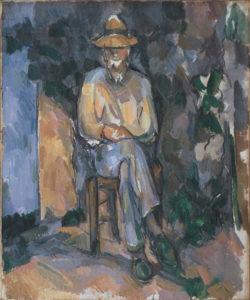R950 – Le Jardinier Vallier, 1905-1906 (FWN547)
RW640 – Portrait de Vallier, 1906
Pavel Machotka
(Cliquer sur l’image pour l’agrandir)
_____
The aquarelle of the gardener Vallier (RW640), presumably preparatory to the oil, is as distinguished as the oil painting; it is complete in itself and stands alone as a work of art. Cézanne neither started out realistically, drawing details that would later be suppressed (as he had is several perparatory studies), nor imposed a rhythm on the background that might not work in the oil, but addressed directly the interplay of light and shadow that would be crucial in the oil. The slight, thin-legged figure of Vallier is already without a face, as if anticipating the abstractions of the canvas, and is insignificant in relation to the lush background; he sits in the sun in front of a climbing plant which is in shadow, with the color of his shirt and pants left bleached. All the subtleties of Cézanne’s watercolor technique are lavished on the complex, abstract, relationships of the hues in the foliage. There, blues, greens, reds and orange-browns are laid in patches one on top of the other; they almost create a landscape, although it is a landscape with a limited purpose: to throw the figure into full sunlight.
Almost the same words could be used to describe the canvas, except that the patches are opaque, and that the greens and blues cannot absorb the intrusion of red; the red is displaced further outward. Where the only way to portray the intensity of the sun in the watercolor was to leave the white of the paper in reserve, on the canvas its place can be taken by yellows and yellow-browns. Now it makes sense for Cézanne to have broadened the canvas to take in the blue area: the blue stands in the same relation to the yellow wall as the pants do to the shirt, and both yellows are that much more intense. In neither work do we see the person of the gardener, however; in both, he is a pretext for a work that is defined by intense relationships of color.
Source: Machotka, Cézanne: the Eye and the Mind.



